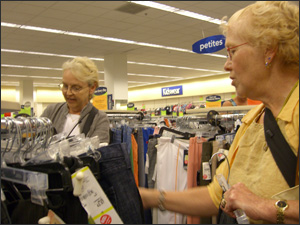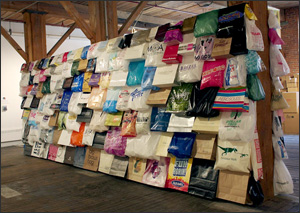 |
 | ||
|
part 1, 2
Everyone wants a bargain At the Mall of America in Minneapolis, Kathy Clark and her shopping buddy Marilyn Bamford are headed for the cash register at Nordstrom Rack, one of their favorite stores. "I've never had a pair of blue shoes," Kathy says, with obvious delight. She's just picked out a pair of sky blue Keens. Kathy and Marilyn have been shopping together for 30 years. A couple of times a year they make a two-day trip to the Mall of America from Duluth, Minnesota. They both love clothes - especially Kathy - and these days they also shop for their grandchildren. When they took the spendthrift-tightwad survey, it turned out that each of them leans toward being a spendthrift. "I might end up on the spendthrift side, but it's got to be at least 50 percent off," Kathy says. "And if it's a really good deal, and I like it and it fits, then I have a terrible time not buying it." The research says that's just how other spendthrifts behave. "People who lean spendthrift tend to think about how much they're saving, so they definitely enjoy getting those bargains," says Scott Rick, the researcher. "Tightwads tend to think still about how much they're spending, rather than saving." That's how it works at Kathy Clark's house. Her husband Terry scored as a borderline tightwad on the shopping survey. He wears the same clothes for years, and he never goes on an all-day shopping excursion. "Good Lord, I'd never make a day of it," he says. "I'm not that interested." Researchers say these mixed shopping marriages can be tough. Extreme spendthrifts and tightwads have a tendency to get cranky with one another. But neither of the Clarks is extreme. They're both on the borderlines, and they don't seem to clash. Terry Clark smiles when he talks about Kathy's spending habits. And he points out that he does buy things. "My shopping role is the big stuff," he says. "Cars. Tires. Furnace. Plumbing." That's not surprising to Scott Rick, either. His research shows that tightwads don't have so much trouble buying durable goods like cars and plumbing. Tightwads do tend to have trouble spending money on things like taxi cabs and eating in restaurants. "You pay for a taxi ride after it's been consumed," Rick says. The same is true for a restaurant meal. "When you fork over the money there's nothing you can expect to receive in the future, and tightwads find these things very painful." For contrast, consider a washer and dryer. The differences between tightwads and spendthrifts are less dramatic when you look at things like household appliances. "When you pay money for a washer and dryer you typically expect to receive a lot of years of use out of it," Rick says. "So tightwads sort of catch up with spendthrifts when it comes to durables." Terry and Kathy Clark are typical in another way, too. He, the guy, leans towards being a tightwad, and she, the gal, is more of a spendthrift. When Scott Rick and his fellow researchers tallied thousands of surveys they found men much more likely to be tightwads, and women much more likely to be spendthrifts. Prof. George Loewenstein says these shopping tendencies seem to be rooted in biology, but he can't be sure yet. Researchers have looked for genetic clues about whether a person is a tightwad or a spendthrift. So far, no luck. But they haven't been able to trace the roots of shopping behavior to people's upbringings, either. "We can't identify any kind of childhood experiences that lead people to be one or the other," he says. "People do tell us that they believe that they knew pretty early on that they were a tightwad or a spendthrift." It's possible that people are born as tightwads and spendthrifts, Loewenstein says, and it isn't clear how much they can change.
The Recovering Tightwad
Rosemary Williams doesn't like to shop. She moved to Minnesota from New York City a couple years ago, and she found herself sort of horrified by the Mall of America. Here in her new hometown was the biggest retail space in the country. But she was fascinated, too. She's an artist, and a professor of new media at St. Cloud State University, and the mall gave her an idea for an art installation. "I wanted to make a giant wall out of shopping bags from the Mall of America," she says. She decided to collect a shopping bag from every store at the mall, but it turned out the stores wouldn't give their bags away without a purchase. She really wanted those bags, so she got a new idea: Buy things. "Return them the next visit, buy more stuff, get more bags," Williams recalls the plan. The shopping frenzy began. She made 26 trips to the mall over the space of about 10 weeks. She bought something at more than 300 stores.
"And I spent over $15,000," she says. Most of it went back, but not all of it. "There was definitely a little bit of a gap," she says with a sheepish grin. "I don't think my husband even knows exactly." She won't say how big the gap is, how much stuff she kept. But it just so happens that Rosemary Williams has a Web site that tells the tale of her shopping adventures, and it includes how much money she spent on each trip. A couple of minutes with a calculator clears up the mystery. She kept close to $3000 of merchandise. That's over now. She's only been to the Mall of America a few times since then, and these days "shopping" usually means a trip to Target for socks and toothpaste. But Williams believes her Mall of America binge did change her a little. Now she's more willing to buy herself a nice pair of pants or a shirt once in a while - without guilt. "It kind of freed my inner shopper," she says. "As small and pathetic as that inner shopper is, it did get freed in that process." It's not clear how much we really can change our inner shoppers. Researchers haven't examined whether people move along the spendthrift-tightwad scale over time. Scott Rick says that would call for a longitudinal study - following people over the course of many years to see if they change. Rick doesn't know the answer yet, but he suspects people cannot change their root tendencies. He may be drawing in part on personal experience. He's trying to curb his own spendthrift ways. He has stories to tell of things he shouldn't have bought - like the ukulele that ended up in the closet. He's trying to slide closer to the middle of the scale. "I've learned all this about the terrible misery that people have when they're in debt and all this kind of stuff," he says. "But I still don't want to make dinner at home. I'm much happier to go out to eat much too often." He laughs. "I think it's hard to change," he says.
Back to Desire of Desire | ||


